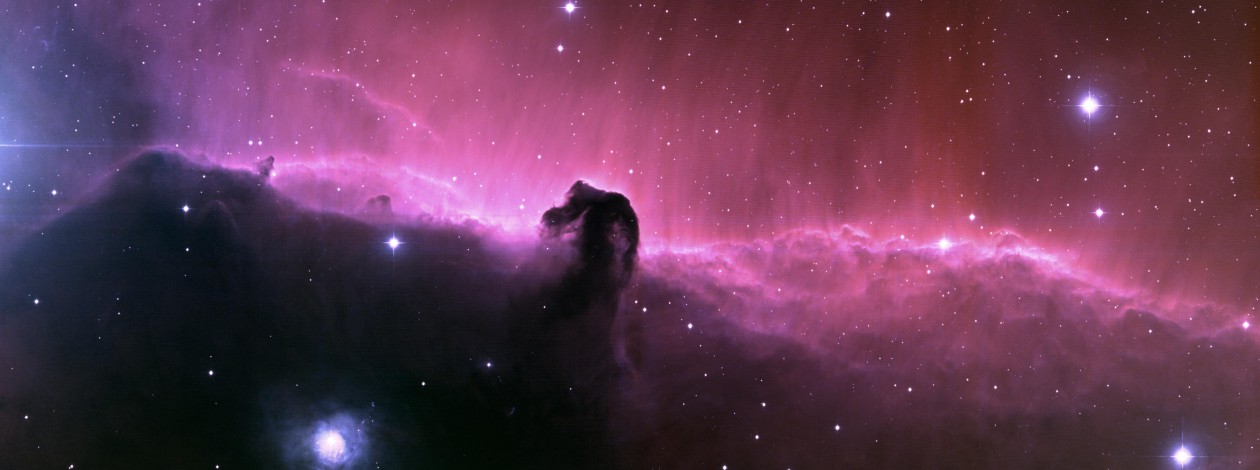
Image Credit & Copyright: Optical (RGB+Ha): Aldo Mottino & Ezequiel Bellocchio (Argentina); Infrared: ESO/J. Emerson/VISTA.
The Nebula
The Flame Nebula, designated as NGC 2024 and Sh2-277, is an emission nebula in the constellation Orion. It is about 900 to 1,500 light-years away.
The bright star Alnitak (ζ Ori), the easternmost star in the Belt of Orion, shines energetic ultraviolet light into the Flame and this knocks electrons away from the great clouds of hydrogen gas that reside there. Much of the glow results when the electrons and ionized hydrogen recombine. Additional dark gas and dust lies in front of the bright part of the nebula and this is what causes the dark network that appears in the center of the glowing gas. The Flame Nebula is part of the Orion Molecular Cloud Complex, a star-forming region that includes the famous Horsehead Nebula.
So how do you find it? Sounds simple. Find the belt. look to the star Alnitak (if you need help, check the image) it’s the left most star in the belt. But not just any telescope is goign to let you see it. I had to locate Alnitak and look around it, with the star in the edge of the shot, Then increase the shutter time until I saw hints of it. I then saw stars in the nebula and used that as a guide to center the image.
The SIMBAD entry is here.

Seeing and photographing:
So now that you located it, it looks empty in the space where it should be. . .So this is where long exposure and a guide scope come into play. The images I got were using a Celestron 6se, I have been a member of a few forums who repeatedly tell me I can see these or don’t waste your time with the guide scope. Well I’m here to tell you they are wrong.
In the 6″ aperture you can get an image, to get a wider field view and to make the optics faster from an F/10 telescope I use a focal reducer from Orion, this one right here. using the guide scope once I found it I was able to stay on target. . well pretty well. at exposures of 150second (2 1/2 minutes) it started to streak. with one good image at this exposure I was able to layer it with ones from 45 second & 90 seconds. It is that faint. so far using the focal reducer makes focusing a tad bit touchy, but I feel I was able o focus it a bit better than my Orion.
To process I process each shot separately then line them up manually. there are programs out there, but none seem to work properly or do anything functional that I can see. By adjusting levels and curves you can bring the faint details to the surface. I will write an article on this just have to use an image to get it right. I started out and read instructions which were not very clear and I didn’t understand how to blend properly. I was beginning to think I needed a photo shop class, so I want to help others in my predicament now that I understand it.
Once you line each one up, you have to properly blend the images so they all show the detail from each image. . after all no one wants a blown out section.. . or a too dark section.
I consider myself a champion of the 6SE. because it is affordable and it works. I think it is honestly underused. The community I have found to be helpful but to a degree the main thing you run into is buy the expensive things because it’s easier. If you run into a challenge, throw money at it till it goes away. The less expensive things work. And with out further delay I resent my Flame nebula, I was,’t supposed to be able to get this with the 6″.

While not as good as some images I’ve seen, considering the limitations I’m working with, I’m surprised I got this.
Unfortunately, this site only lets you use Jpegs, so if you want to see a larger res tif, check my photo album here on Flikr so keep looking and keep pushing the boundaries.
Facts and Figures:
| Observation data: J2000.0 epoch | |
|---|---|
| Right ascension | 05h 41m 54s |
| Declination | −1° 51′ 0.0″ |
| Distance | 900–1,500 ly |
| Apparent magnitude (V) | +2 |
| Apparent dimensions (V) | 30’x30′ |
| Constellation | Orion |
| Designations | NGC 2024 and Sharpless 277 |

